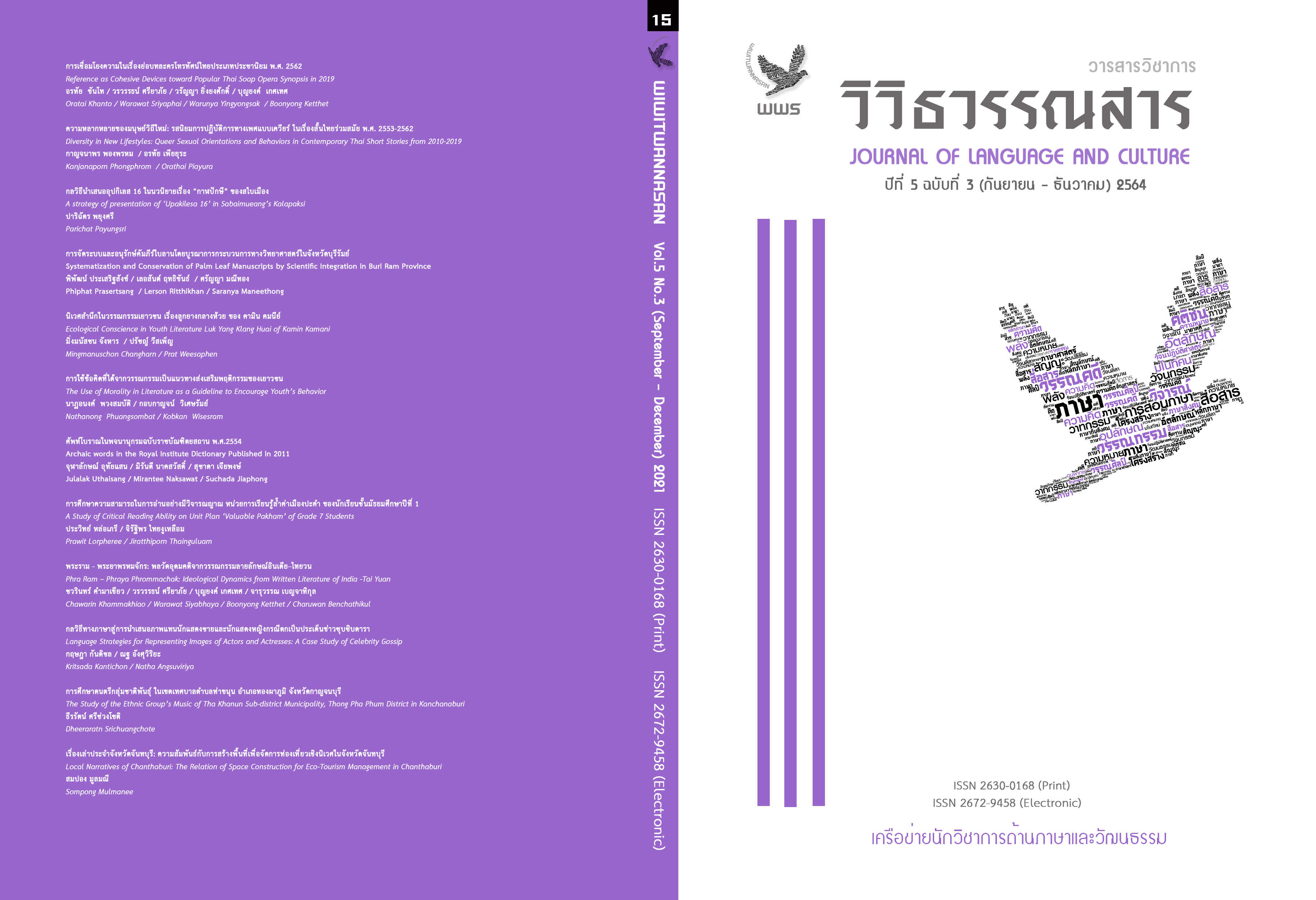การเชื่อมโยงความโดยการอ้างถึงในบทละครไทยโทรทัศน์ประชานิยม พ.ศ. 2562
Main Article Content
บทคัดย่อ
บทความนี้มีวัตถุประสงค์เพื่อศึกษาการเชื่อมโยงความโดยการอ้างถึงในบทละครไทยโทรทัศน์ประชานิยม พ.ศ. 2562 โดยศึกษาตามแนวคิดเรื่องการอ้างถึง ข้อมูลในการวิเคราะห์เป็นตัวบทละครไทยโทรทัศน์ที่ได้รับความนิยมในการรับชมมากที่สุดปี พ.ศ. 2562 จำนวน 3 เรื่อง ได้แก่ ผู้บ่าวอินดี้ ยาหยีอินเตอร์, สารวัตรใหญ่ และ กรงกรรม ผลการศึกษาสรุปได้ว่า ลักษณะกลไกการเชื่อมโยงความโดยการอ้างถึงในบทละครไทยโทรทัศน์ ประชานิยม พ.ศ. 2562 จำแนกได้ 3 ลักษณะ คือ ประการแรก การอ้างถึงด้วยหน่วยนามและสรรพนาม คือ หน่วยบุรุษสรรพนาม ได้แก่ หน่วยบุรุษสรรพนามที่ 1 บุรุษที่ 2 และบุรุษที่ 3 และหน่วยนามที่ทำหน้าที่เหมือนหน่วยสรรพนามพบ 6 ประเภท คือ 1) หน่วยเรียกชื่อเฉพาะ 2) หน่วยเรียกญาติ 3) หน่วยเรียกตำแหน่ง 4) หน่วยเรียกอาชีพ 5) หน่วยเรียกฉายานาม 6) หน่วยแสดงความเป็นเจ้าของ ประการที่สอง การอ้างถึงเชิงบ่งชี้ พบการใช้รูปภาษาการบ่งชี้ด้วยคำวิเศษณ์ เช่น นี้, นั้น,โน้น,นี่, นั่น,นู่น และประการที่สามการอ้างถึงเชิงเปรียบเทียบ พบลักษณะการเปรียบเทียบในแง่เปรียบความเหมือน
Article Details
ลิขสิทธิ์ของบทความเป็นของวารสาร การพิมพ์ซ้ำจะต้องได้ร้บการอนุญาตจากบรรณาธิการวารสาร
เอกสารอ้างอิง
Kunnawut, S. (2019, June 26). Pu bao Indy Yayee Inter (In Thai) [Mister Indy Honey Hipster]. Retrieved form https://mgronline.com/drama/detail/9620000057118
Tiangtam, N. (2019, April 30). Krongkam (In Thai) [The karma cage]. Retrieved form https://mgronline.com/drama/detail/9620000015257
Angsuviriya, C. (2016). Kan Anang thung thi prakong nai nangsue ratchakan phrabath sondec phramongkudklao jao yu hua (i n Thai) [Referencing in King Rama VI's Book of Governing Principles]. Academic Journal of Humanities and Social Sciences Burapha University, 24(44), 195-217. Retrieved from https://so06.tci- thaijo.org/index.php/husojournal/article/view/55973
Burusphat, S.(1994).Discourse Analysis. Research Institute for Languages and Cultures of Asia Mahidol University, Bangkok.
Nielsen. (2020,January 1).10 lakhon Dang tam retting sungsut prajam pi 2019 (In Thai) [10 famous dramas making the highest ratings in 2019]. Retrieved form https:www.sanook.com/movie/93649/
Ngampradit, S. (1997). Cohesion in television news reporting: scripted vs. non-scripted news. (In Thai). (Master’s thesis). Thammasat University, Bangkok.
Paksasuk, A (2010). Kan cheum yong khwam nai ni than wetal phra niphon pael khong phra ra cha wo ra wong the krom muen phit tha ya long korn (in Thai) [Cohesion in Vetala Translated by H.H. Prince Bidyalongkarana]. The Journal of Vananvidas, 10, (21-53). Retrieved from https://doi.org/10.14456/vannavidas.2010.2
Panupong, W. (2009). Thai language norms vol. 3 types of words, phrases, sentences and relativity. Office of the Basic Education Commission : Bangkok.
Panyametheekul, S. (2003). COHERENCE OF INTERACTIONS IN A THAI CHATROOM: INTERPLAY OF COHESION, TURN-ALLOCATION, AND RELEVENCE. (Doctor of Arts in Linguistics). Chulalongkorn University, Bangkok.
Sriyaphai, W. (2009). LINGUISTIC FORMS REFERRING TO PARTICIPANTS IN THAI POETIC LITERATURE. (In Thai). (Doctoral dissertation). Mahasarakham University, Bangkok.
________. (2020). Yona Lae khokhwam nai Pasathai. (In Thai) [Paragraphs and texts in Thai]. Sukhothai Thammathirat University, Nontaburi.
Jirabovornwisut, S. (2011). DEVELOPMENT AND AESTHETIC CONCEPT OF THAI TELEVISION- DRAMA SCRIPT. (Master’s thesis). Chulalongkorn University, Bangkok.


